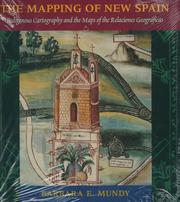| Listing 1 - 6 of 6 |
Sort by
|

ISBN: 0226550966 Year: 1996 Publisher: Chicago : University of Chicago Press,
Abstract | Keywords | Export | Availability | Bookmark
 Loading...
Loading...Choose an application
- Reference Manager
- EndNote
- RefWorks (Direct export to RefWorks)
Aztec cartography --- Cartography --- Indian cartography --- History. --- 528.9 --- Cartography. Mapping (textual documents) --- 528.9 Cartography. Mapping (textual documents) --- Cartography, Indian --- Indians --- Cartography, Primitive --- Chartography --- Map-making --- Mapmaking --- Mapping (Cartography) --- Mathematical geography --- Surveying --- Map projection --- Maps --- Aztecs --- Cartography, Aztec --- History --- Mexico --- New Spain --- Cartography - Mexico - History. --- Cartography - New Spain - History. --- Indian cartography - New Spain - History. --- Aztec cartography - History.
Book
ISBN: 0292766572 0292766564 0292766580 Year: 2015 Publisher: Austin, Texas : University of Texas Press,
Abstract | Keywords | Export | Availability | Bookmark
 Loading...
Loading...Choose an application
- Reference Manager
- EndNote
- RefWorks (Direct export to RefWorks)
"In 1325, the Aztecs founded their capital city Tenochtitlan, which grew to be one of the world's largest cities before it was violently destroyed in 1521 by conquistadors from Spain and their indigenous allies. Re-christened and reoccupied by the Spanish conquerors as Mexico City, it became the pivot of global trade linking Europe and Asia in the 17th century, and one of the modern world's most populous metropolitan areas. However, the Aztec city of Tenochtitlan and its people did not entirely disappear when the Spanish conquistadors destroyed it. By reorienting Mexico City-Tenochtitlan as a colonial capital and indigenous city, Mundy demonstrates its continuity across time. Using maps, manuscripts, and artworks, she draws out two themes: the struggle for power by indigenous city rulers and the management and manipulation of local ecology, especially water, that was necessary to maintain the city's sacred character. What emerges is the story of a city-within-a city that continues to this day"-- "The capital of the Aztec empire, Tenochtitlan, was, in its era, one of the largest cities in the world. Built on an island in the middle of a shallow lake, its population numbered perhaps 150,000, with another 350,000 people in the urban network clustered around the lake shores. In 1521, at the height of Tenochtitlan's power, which extended over much of Central Mexico, Hernando Cortes and his followers conquered the city. Cortes boasted to King Charles V of Spain that Tenochtitlan was 'destroyed and razed to the ground.' But was it? Drawing on period representations of the city in sculptures, texts, and maps, The Death of Aztec Tenochtitlan, the Life of Mexico City builds a convincing case that this global capital remained, through the sixteenth century, very much an AmerIndian city. Barbara E. Mundy foregrounds the role the city's indigenous peoples, the Nahua, played in shaping Mexico City through the construction of permanent architecture and engagement in ceremonial actions. She demonstrates that the Aztec ruling elites, who retained power even after the conquest, were instrumental in building and then rebuilding the city. Mundy shows how the Nahua entered into mutually advantageous alliances with the Franciscans to maintain the city's sacred nodes. She also focuses on the practical and symbolic role of the city's extraordinary waterworks--the product of a massive ecological manipulation begun in the fifteenth century--to reveal how the Nahua struggled to maintain control of water resources in early Mexico City"--
Nahuas --- Aztecs --- Power (Social sciences) --- Sacred space --- Architecture --- Water-supply --- History. --- Mexico City (Mexico) --- History --- Social life and customs. --- Environmental conditions. --- Availability, Water --- Water availability --- Water resources --- Natural resources --- Public utilities --- Water resources development --- Water utilities --- Architecture, Western (Western countries) --- Building design --- Buildings --- Construction --- Western architecture (Western countries) --- Art --- Building --- Holy places --- Places, Sacred --- Sacred places --- Sacred sites --- Sacred spaces --- Sites, Sacred --- Space, Sacred --- Holy, The --- Religion and geography --- Empowerment (Social sciences) --- Political power --- Exchange theory (Sociology) --- Political science --- Social sciences --- Sociology --- Consensus (Social sciences) --- Aztec Indians --- Azteca Indians --- Aztecan Indians --- Mexica Indians --- Tenocha Indians --- Indians of Mexico --- Mexicano Indians --- Naguatl Indians --- Nahoa Indians --- Nahua Indians --- Nahuate Indians --- Nahuatl Indians --- Nahuatleca Indians --- Uto-Aztecan Indians --- Design and construction --- Tenochtitlán (Mexico) --- Temestitán (Mexico) --- Temixtitan (Mexico) --- Mexiko Stadt (Mexico) --- Ciudad de México (Mexico) --- City of Mexico (Mexico) --- CDMX (Mexico) --- メキシコシティー (Mexico) --- Mekishikoshitī (Mexico) --- Distrito Federal (Mexico) --- Mégico (Mexico) --- Architecture, Primitive
Book
ISBN: 9780292766570 0292766572 9780292766563 0292766564 Year: 2021 Publisher: Austin
Abstract | Keywords | Export | Availability | Bookmark
 Loading...
Loading...Choose an application
- Reference Manager
- EndNote
- RefWorks (Direct export to RefWorks)
Digital
Abstract | Keywords | Export | Availability | Bookmark
 Loading...
Loading...Choose an application
- Reference Manager
- EndNote
- RefWorks (Direct export to RefWorks)
Art --- Latin American --- Colonial Latin American fine arts styles --- Mexican --- invloed van Vlaamse school --- kunstenaarschap --- artists [visual artists] --- Vasari, Giorgio --- Rubens, Peter Paul --- anno 1500-1799 --- Mexico
Book
ISBN: 9780292766563 Year: 2015 Publisher: Austin University of Texas
Abstract | Keywords | Export | Availability | Bookmark
 Loading...
Loading...Choose an application
- Reference Manager
- EndNote
- RefWorks (Direct export to RefWorks)
Book

ISBN: 3110608170 9783110608755 9783110608175 Year: 2022 Publisher: Berlin Boston
Abstract | Keywords | Export | Availability | Bookmark
 Loading...
Loading...Choose an application
- Reference Manager
- EndNote
- RefWorks (Direct export to RefWorks)
Information technology --- Religious aspects. --- Digital media --- Religion and the humanities. --- Médias numériques --- Religion et sciences humaines. --- Aspect religieux.
| Listing 1 - 6 of 6 |
Sort by
|

 Search
Search Feedback
Feedback About UniCat
About UniCat  Help
Help News
News